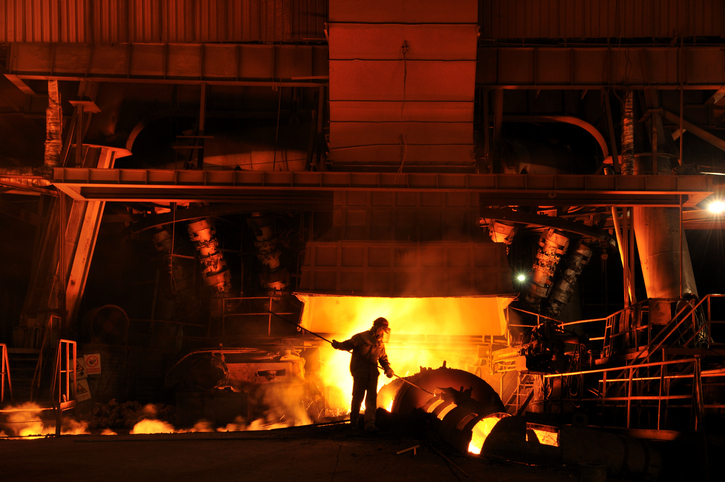
The Biden administration is right to maintain them.
President Biden continued his first overseas trip today by meeting with leaders of the European Union in Belgium, where the US and EU sides agreed to work together on climate change policy and the ongoing response to the Covid-19 pandemic. The two sides even settled a longstanding trade dispute over airplanes.
However, a more recent dispute over American tariffs on European steel and aluminum was not settled. In a joint statement released following the summit, the sides announced they “will engage in discussions to allow the resolution of existing differences on measures regarding steel and aluminum before the end of the year.” They’ll also both “commit to ensure the long-term viability of our steel and aluminum industries, and to address excess capacity.”
It appears the tariffs’ clamorous critics aren’t yet getting what they want, and that’s good. The president shouldn’t hit rewind and return our government to trade policies that hollowed out critical American industries like steel. No; if the countries of the European Union want the Biden administration to remove the 25% steel tariffs imposed in 2018, they should first take some confidence-building steps of their own.
First, let’s get the obvious caveat out of the way: The European Union doesn’t represent a national security threat to the United States. But many of its economic and trade policies – and its attitudes toward China’s – have indeed undermined the American steel sector and impacted our domestic politics.
America and Europe are allies, but business is business. While most of the distortion in the global steel market can be traced back to the gargantuan, state-backed and carbon-intensive Chinese steel industry, in recent years the U.S. government has authorized 40 separate anti-dumping and countervailing duty actions against European steel and aluminum imports. Those didn’t simply appear out of the ether; in every case it brought the American steel industry was required to show damage to its operations or jobs caused by steel imports from Europe, and it did so successfully.
Presently, they haven’t exactly been pulling their weight toward a global economic recovery. With the U.S. poised to experience an economic boom and make major new public investments, let’s not forget the recent fiscal policies of some EU members who have relied heavily on export-led growth rather than internal consumption. That has exacerbated both trade imbalances and tensions. The EU has begun taking steps toward economic stimulus over the past year; now it should commit to maintain them.
And when it comes to challenging aggressive Chinese trading behavior, which President Biden has urged his international counterparts to do, the EU has been less than enthusiastic. Its safeguard mechanism for deterring against dumped and subsidized steel is notoriously weak, and on the specific issue of global overcapacity in the steel sector it has been content with dialogue at the OECD and G20, rather than pursuing a solution that would include actual enforcement.
Meanwhile, the fundamental problem that made the “Section 232” tariffs necessary – global production overcapacity in the international steel and aluminum industries – has only grown worse during the pandemic. Led by the state-owned enterprises in China and compounded by the industries in Brazil, India, Turkey and elsewhere, there are more mills coming online that the market simply hasn’t shown demand for.
That means the tariffs, which have been crucial to the recovery for America’s steel manufacturers and workers, should stay right where they are.
These tariffs, which were put in place to adjust for grossly misaligned international prices on steel and aluminum, haven’t regressed the American market into some kind of autarky. Even with the steel tariffs in place the U.S. remains remarkably open to imports, which accounted for 27.8% of domestic consumption in 2019. On the other hand, imports comprised 26.1% of the EU’s domestic steel consumption that year.
Put another way: The U.S. still lets in more imported steel than the EU. But instead of opening its own steel market in recent months, the EU’s ambassador to the United States chose to take sides with American steel consumers and importers as they launched an attempt to remove the tariffs. That’s hardly a step toward productive dialogue with the Biden administration, and I hope it’s one that doesn’t go unnoticed as negotiations continue.
Despite all of this, and according to today’s post EU-US summit statement, the Biden administration and its European counterparts are currently in a ceasefire: The tariffs will remain while the sides negotiate a drawdown toward the end of the year.
There’s a reason it’s playing out this way instead of the tariffs being unilaterally revoked: President Biden knows they’re working. Limiting metals imports has allowed the space for our domestic steel and aluminum industries to make significant capital investments, reclaim and create thousands of jobs, and green their operations, which will further improve their competitiveness. Reports have shown the tariffs have had no measurable effect on overall costs for consumers of these metals.
The EU, therefore, shouldn’t expect the US to bend too much. Overcapacity is the nagging problem, and the Biden administration, by maintaining these tariffs, is still doing something about it. And Europe should commit to doing the same.
